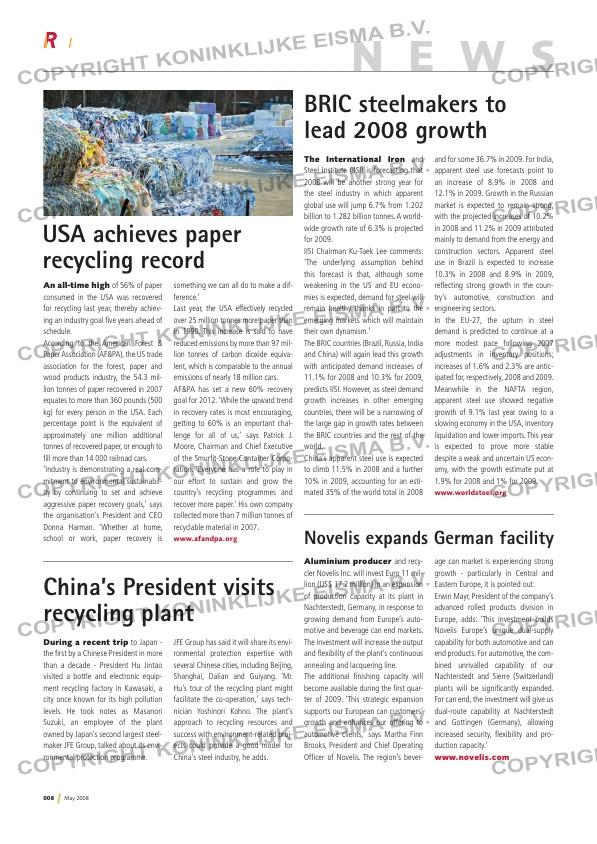Page 8 from: May 2008

008 May 2008
n e w s
An all-time high of 56% of paper
consumed in the USA was recovered
for recycling last year, thereby achiev-
ing an industry goal five years ahead of
schedule.
According to the American Forest &
Paper Association (AF&PA), the US trade
association for the forest, paper and
wood products industry, the 54.3 mil-
lion tonnes of paper recovered in 2007
equates to more than 360 pounds (500
kg) for every person in the USA. Each
percentage point is the equivalent of
approximately one million additional
tonnes of recovered paper, or enough to
fill more than 14 000 railroad cars.
‘Industry is demonstrating a real com-
mitment to environmental sustainabil-
ity by continuing to set and achieve
aggressive paper recovery goals,’ says
the organisation’s President and CEO
Donna Harman. ‘Whether at home,
school or work, paper recovery is
something we can all do to make a dif-
ference.’
Last year, the USA effectively recycled
over 25 million tonnes more paper than
in 1990. This increase is said to have
reduced emissions by more than 97 mil-
lion tonnes of carbon dioxide equiva-
lent, which is comparable to the annual
emissions of nearly 18 million cars.
AF&PA has set a new 60% recovery
goal for 2012. ‘While the upward trend
in recovery rates is most encouraging,
getting to 60% is an important chal-
lenge for all of us,’ says Patrick J.
Moore, Chairman and Chief Executive
of the Smurfit-Stone Container Corpo-
ration. ‘Everyone has a role to play in
our effort to sustain and grow the
country’s recycling programmes and
recover more paper.’ His own company
collected more than 7 million tonnes of
recyclable material in 2007.
www.afandpa.org
USA achieves paper
recycling record
Aluminium producer and recy-
cler Novelis Inc. will invest Euro 11 mil-
lion (US$ 17.2 million) in an expansion
of production capacity at its plant in
Nachterstedt, Germany, in response to
growing demand from Europe’s auto-
motive and beverage can end markets.
The investment will increase the output
and flexibility of the plant’s continuous
annealing and lacquering line.
The additional finishing capacity will
become available during the first quar-
ter of 2009. ‘This strategic expansion
supports our European can customers’
growth and enhances our offering to
automotive clients,’ says Martha Finn
Brooks, President and Chief Operating
Officer of Novelis. The region’s bever-
age can market is experiencing strong
growth – particularly in Central and
Eastern Europe, it is pointed out.
Erwin Mayr, President of the company’s
advanced rolled products division in
Europe, adds: ‘This investment builds
Novelis Europe’s unique dual-supply
capability for both automotive and can
end products. For automotive, the com-
bined unrivalled capability of our
Nachterstedt and Sierre (Switzerland)
plants will be significantly expanded.
For can end, the investment will give us
dual-route capability at Nachterstedt
and Gottingen (Germany), allowing
increased security, flexibility and pro-
duction capacity.’
www.novelis.com
Novelis expands German facility
The International Iron and
Steel Institute (IISI) is forecasting that
2008 will be another strong year for
the steel industry in which apparent
global use will jump 6.7% from 1.202
billion to 1.282 billion tonnes. A world-
wide growth rate of 6.3% is projected
for 2009.
IISI Chairman Ku-Taek Lee comments:
‘The underlying assumption behind
this forecast is that, although some
weakening in the US and EU econo-
mies is expected, demand for steel will
remain healthy thanks in part to the
emerging markets which will maintain
their own dynamism.’
The BRIC countries (Brazil, Russia, India
and China) will again lead this growth
with anticipated demand increases of
11.1% for 2008 and 10.3% for 2009,
predicts IISI. However, as steel demand
growth increases in other emerging
countries, there will be a narrowing of
the large gap in growth rates between
the BRIC countries and the rest of the
world.
China’s apparent steel use is expected
to climb 11.5% in 2008 and a further
10% in 2009, accounting for an esti-
mated 35% of the world total in 2008
and for some 36.7% in 2009. For India,
apparent steel use forecasts point to
an increase of 8.9% in 2008 and
12.1% in 2009. Growth in the Russian
market is expected to remain strong,
with the projected increases of 10.2%
in 2008 and 11.2% in 2009 attributed
mainly to demand from the energy and
construction sectors. Apparent steel
use in Brazil is expected to increase
10.3% in 2008 and 8.9% in 2009,
reflecting strong growth in the coun-
try’s automotive, construction and
engineering sectors.
In the EU-27, the upturn in steel
demand is predicted to continue at a
more modest pace following 2007
adjustments in inventory positions;
increases of 1.6% and 2.3% are antic-
ipated for, respectively, 2008 and 2009.
Meanwhile in the NAFTA region,
apparent steel use showed negative
growth of 9.1% last year owing to a
slowing economy in the USA, inventory
liquidation and lower imports. This year
is expected to prove more stable
despite a weak and uncertain US econ-
omy, with the growth estimate put at
1.9% for 2008 and 1% for 2009.
www.worldsteel.org
BRIC steelmakers to
lead 2008 growth
During a recent trip to Japan –
the first by a Chinese President in more
than a decade – President Hu Jintao
visited a bottle and electronic equip-
ment recycling factory in Kawasaki, a
city once known for its high pollution
levels. He took notes as Masanori
Suzuki, an employee of the plant
owned by Japan’s second largest steel-
maker JFE Group, talked about its envi-
ronmental protection programme.
JFE Group has said it will share its envi-
ronmental protection expertise with
several Chinese cities, including Beijing,
Shanghai, Dalian and Guiyang. ‘Mr.
Hu’s tour of the recycling plant might
facilitate the co-operation,’ says tech-
nician Yoshinori Kohno. The plant’s
approach to recycling resources and
success with environment-related proj-
ects could provide a good model for
China’s steel industry, he adds.
China’s President visits
recycling plant
RI_082_NEWS.indd 2 14-05-2008 14:07:33



